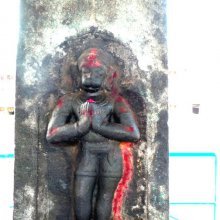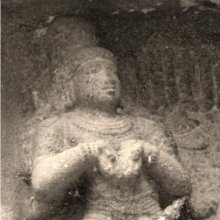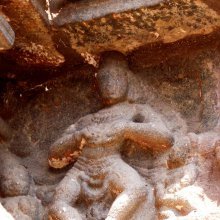Pushpaputa, Puṣpapuṭa, Pushpa-puta: 11 definitions
Introduction:
Pushpaputa means something in Hinduism, Sanskrit. If you want to know the exact meaning, history, etymology or English translation of this term then check out the descriptions on this page. Add your comment or reference to a book if you want to contribute to this summary article.
The Sanskrit term Puṣpapuṭa can be transliterated into English as Puspaputa or Pushpaputa, using the IAST transliteration scheme (?).
Images (photo gallery)
In Hinduism
Natyashastra (theatrics and dramaturgy)
Source: Wisdom Library: Nāṭya-śāstraPuṣpapuṭa (पुष्पपुट) refers to a gesture (āṅgika) made with ‘combined hands’ (saṃyuta), according to the Nāṭyaśāstra chapter 8. The hands (hasta) form a part of the human body which represents one of the six major limbs (aṅga) used in dramatic performance. With these limbs are made the various gestures (āṅgika), which form a part of the histrionic representation (abhinaya).
Source: archive.org: The mirror of gesture (abhinaya-darpana)One of the saṃyutta-hastāni (Twenty-four combined Hands).—Puṣpapuṭa (flower-casket): Sarpa-śīrṣa hands are pressed together. Usage: offering lights (ārati), twilight water offering (sandhya-argha-dāna), flower-spells (mantra-puṣpa), children receiving fruits, etc.
According to another book: one Sarpa-śīrṣa hand by the side of the other. The patron deity is Kinnareśvara. Usage: offering and receiving flowers, corn, fruits, or water.
Source: archive.org: Natya ShastraPuṣpapuṭa (पुष्पपुट).—A type of gesture (āṅgika) made with combined hands (saṃyuta-hasta);—(Instructions): Two Sarpaśiraḥ hands with their fingers close to one another meeting on one side very closely will give rise to the Puṣpapuṭa hand.
(Uses): It is to be used to indicate the receiving or carrying of rice, fruits, flowers, foods and lawfully obtained money of various kinds and the carrying and removing of water.
Source: Shodhganga: Elements of Art and Architecture in the Trtiyakhanda of the Visnudharmottarapurana (natya)Puṣpapuṭa (पुष्पपुट) refers to one of the thirteen Saṃyuktahastas or “combined hand gestures” (in Indian Dramas), according to the Viṣṇudharmottarapurāṇa, an ancient Sanskrit text which (being encyclopedic in nature) deals with a variety of cultural topics such as arts, architecture, music, grammar and astronomy.—The hasta-mudrās (lit. “hand-gestures”) are very essential to denote some particular action or state in dancing and these mudrās are formed with the help of hands and fingers.—The word puṣpapuṭa is made with two words viz., puṣpa means flower and puṭa i.e., cavity. According to the Viṣṇudharmottarapurāṇa, in puṣpapuṭa posture, both hands are joined together by their sides and the fingers of both hands should be in sarpaśīrṣa position. In the Abhinayadarpaṇa, this posture is said to use in waving beams in front of the image of god, as an act of adoration, taking of water, fruit etc, giving offerings, evening and a flower invested with magical power.

Natyashastra (नाट्यशास्त्र, nāṭyaśāstra) refers to both the ancient Indian tradition (shastra) of performing arts, (natya—theatrics, drama, dance, music), as well as the name of a Sanskrit work dealing with these subjects. It also teaches the rules for composing Dramatic plays (nataka), construction and performance of Theater, and Poetic works (kavya).
Shilpashastra (iconography)
Source: Shodhganga: The significance of the mūla-beras (śilpa)Puṣpapuṭa (पुष्पपुट) or Puṣpapuṭahasta refers to “worship with flowers” and represents one of the four gestures with both hands, as defined according to texts dealing with śilpa (arts and crafs), known as śilpaśāstras.—Accordingly, pratimā-lakṣaṇa (body postures of the icons) is comprised of hand gestures (hasta, mudrā or kai-amaiti), stances/poses (āsanas) and inflexions of the body (bhaṅgas). There are thirty-two types of hands [viz., puṣpapuṭa-hasta] classified into two major groups known as tolirkai (functional and expressive gestures) and elirkai (graceful posture of the hand).

Shilpashastra (शिल्पशास्त्र, śilpaśāstra) represents the ancient Indian science (shastra) of creative arts (shilpa) such as sculpture, iconography and painting. Closely related to Vastushastra (architecture), they often share the same literature.
Languages of India and abroad
Sanskrit dictionary
Source: DDSA: The practical Sanskrit-English dictionaryPuṣpapuṭa (पुष्पपुट).—the calyx of a flower.
2) (in music) a particular position in dancing.
Derivable forms: puṣpapuṭaḥ (पुष्पपुटः).
Puṣpapuṭa is a Sanskrit compound consisting of the terms puṣpa and puṭa (पुट).
Source: Cologne Digital Sanskrit Dictionaries: Edgerton Buddhist Hybrid Sanskrit DictionaryPuṣpapuṭa (पुष्पपुट).—nt., °pūṭa, m., °pūṭī, f., flower-sheath, calyx: so Tibetan me tog gi phur ma (according to [Tibetan-English Dictionary]) on Mahāvyutpatti 6112 °puṭam, n. sg., in list of ‘articles of worship’ (pūjā- pariṣkārāḥ), between cūrṇa and gandha; Sukhāvatīvyūha shows how they were used, viz., thrown upon a Buddha, or up in [Page350-a+ 71] the air where they remain magically fixed and form um- brellas; in Sukhāvatīvyūha the forms are puṣpa-pūṭī 49.5 and 50.9, or gandha-pūṭī, fragrant calyx (of a flower), 50.1, but puṣpa-pūṭa, masc., in 50.13 (all these are in verses) and, in prose, 57.11 ff., repeatedly, always with ā; Müller renders the second member handfull, [Boehtlingk and Roth] Düte, but the use in Sukhāvatīvyūha confirms Tibetan on Mahāvyutpatti. It is, to be sure, doubt- less connected with Sanskrit puṭa, puṭī, pockét, cavity, con tainer, etc.
Source: Cologne Digital Sanskrit Dictionaries: Monier-Williams Sanskrit-English Dictionary1) Puṣpapuṭa (पुष्पपुट):—[=puṣpa-puṭa] [from puṣpa > puṣ] m. a cup or bag filled with f°, [cf. Lexicographers, esp. such as amarasiṃha, halāyudha, hemacandra, etc.]
2) [v.s. ...] the hands arranged in the shape of the calyx of a f°, [Catalogue(s)]
3) [v.s. ...] (in music) a [particular] position in dancing.
[Sanskrit to German]
Sanskrit, also spelled संस्कृतम् (saṃskṛtam), is an ancient language of India commonly seen as the grandmother of the Indo-European language family (even English!). Closely allied with Prakrit and Pali, Sanskrit is more exhaustive in both grammar and terms and has the most extensive collection of literature in the world, greatly surpassing its sister-languages Greek and Latin.
Kannada-English dictionary
Source: Alar: Kannada-English corpusPuṣpapuṭa (ಪುಷ್ಪಪುಟ):—
1) [noun] (bot.) the outer whorl of protective leaves (sepals) of a flower, which is usu. green; the calyx.
2) [noun] (dance.) a joining of both the palms, slightly hollowed and curved vertically and fingers straightened and facing upwards, resembling a calyx.
Kannada is a Dravidian language (as opposed to the Indo-European language family) mainly spoken in the southwestern region of India.
See also (Relevant definitions)
Partial matches: Pushpa, Puta.
Starts with: Pushpaputahasta.
Ends with: Talapushpaputa.
Full-text: Talapushpaputa, Pushpaputahasta, Puta, Cavity, Samyuta, Flower, Evening, Waving, Giving, Samyuktahasta, Samyutta-hastani.
Relevant text
Search found 5 books and stories containing Pushpaputa, Pushpa-puta, Puṣpa-puṭa, Puspa-puta, Puṣpapuṭa, Puspaputa; (plurals include: Pushpaputas, putas, puṭas, Puṣpapuṭas, Puspaputas). You can also click to the full overview containing English textual excerpts. Below are direct links for the most relevant articles:
Gati in Theory and Practice (by Dr. Sujatha Mohan)
Gati performed as Lokadharmī and Nāṭyadharmī < [Chapter 3 - Application of gati in Dṛśya-kāvyas]
Observations based on Nāṭyaśāstra < [Chapter 5 - Conclusion]
Pallava period (Social and Cultural History) (by S. Krishnamurthy)
Household Articles (d): Flower-basket (Pushpa-puta) < [Chapter 4 - Material Culture of the People]
Dancing girls in temples < [Chapter 3 - Socio-Religious Life]
The priestly class < [Chapter 3 - Socio-Religious Life]
Vishnudharmottara Purana (Art and Architecture) (by Bhagyashree Sarma)
2.2. Hand Postures (b): Saṃyukta-hasta < [Chapter 3 - Drama and Dance]
2. The Viṣṇudharmottara-purāṇa and the Indian Classical Dances < [Chapter 6 - Modern Relevance of Different Art Forms and Architecture]
Abhinaya-darpana (English) (by Ananda Coomaraswamy)
Natyashastra (English) (by Bharata-muni)


